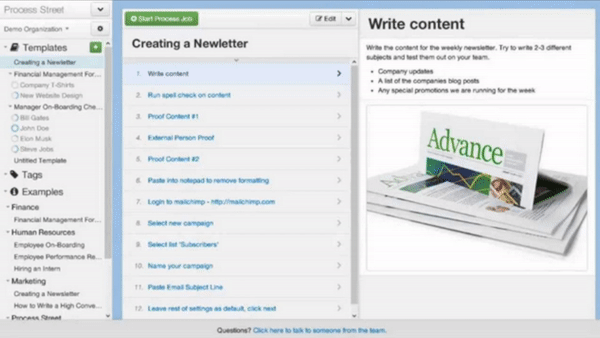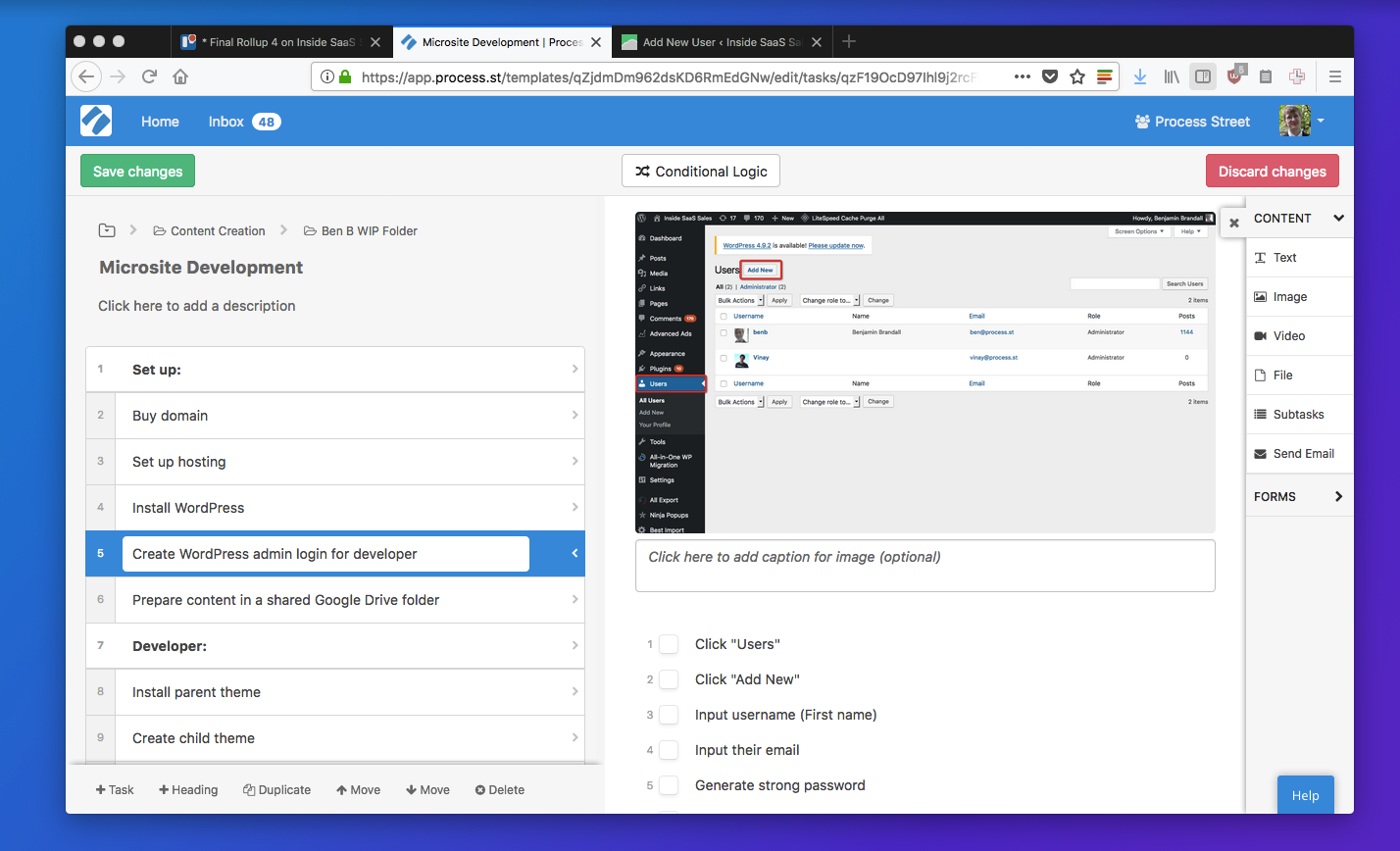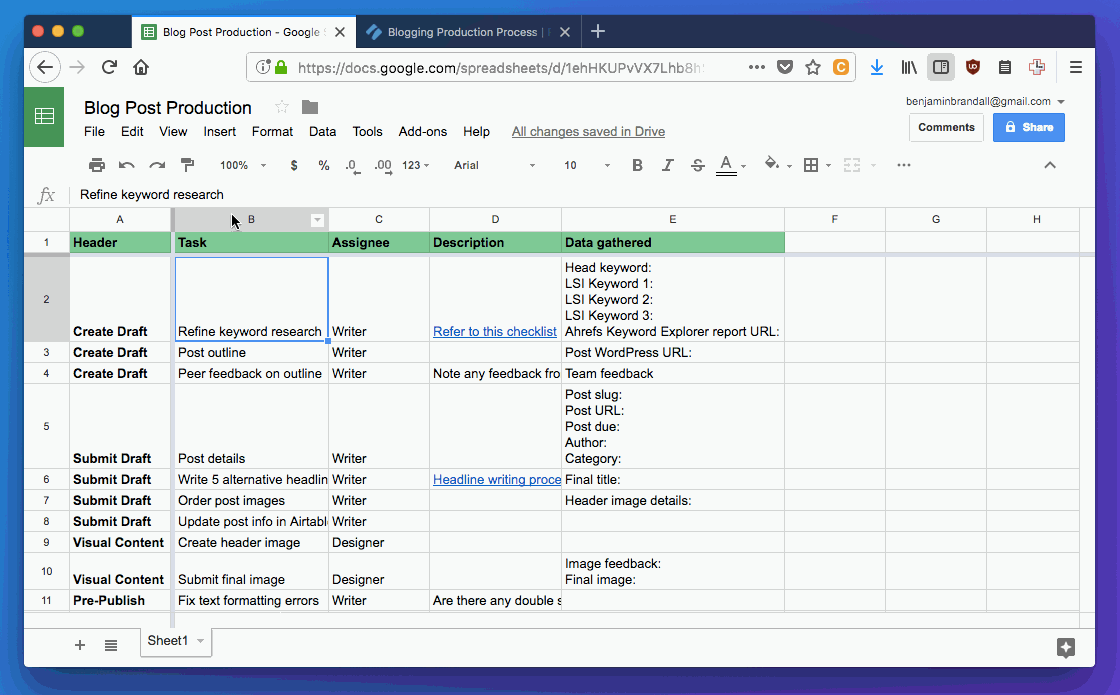We send out feedback requests to new blog subscribers so we know what kind of content to write that will be the most useful. Sometimes, the answers surprise us.
In particular, I often get awesome responses that give me insight into how our customers plan and create their processes:
One reader plans out their processes in a spreadsheet because columns make it easy to build the steps out. Another said they analyze a Trello board of tasks and lists to make sense of how a successful project was executed, then writes a process to recreate those steps. And, of course, we have our suggested ways that we have found our customers have the most success with.
In this post, I’m going to go through four methods you can use to document processes accurately, quickly, and naturally.
- The minimum viable process
- Turning an archived Trello board into a process
- Mapping a process in a spreadsheet
- Turning a screencast into a process
Let’s look at each method in detail.
Method #1: The minimum viable process

This is the method we recommend to absolute beginners, and it can be especially useful to prompt you to just start.
Our sales and customer success teams work directly with customers, hearing about both good and bad methods of process management.
One particular customer we spoke to was stuck in a process paradox:
He had a big batch of Word documents that needed tidying, updating, and turning into formal Process Street templates for his organization. But he also had a problem — he didn’t want to make the switch to Process Street before he had all of his documents transferred over. Sometimes a task can seem too big to start, and that stops us ever making the progress we’ll need to make to see the light at the end of the tunnel.
Dedicating time and money exclusively for process creation is often too much to ask for smaller businesses, though. Enterprises create processes in bursts, working for months at a time to write full playbooks. Not everyone has this privilege, which often means processes don’t get created at all, and your business doesn’t get chance to grow because it’s bogged down in inefficiencies.
The solution? Work on your processes iteratively.
- Choose the highest value process (use the 80/20 principle to find which 20% of your processes generate 80% of business value)
- Do it
- Write down a simple description of each task involved
- Move onto the next process
Over time, with only a little bit of extra effort, you’ve created the first stage of your processes. The next time you revisit the process draft, just add more detail to the steps you need clearing up, until you and your team don’t have to use anything to run the process than the document itself.
It’s like software development. Don’t try to build the entire ‘product’ before you release it. When we first launched Process Street, you could create simple checklists — and that was about it.

There wasn’t a password reset feature or workflow rules, but if we’d have waited until now to release it when it’s ‘perfect’, we would have lost out on a lot of the feedback we needed to create a great product. The same goes for you if you sit on your processes and wait until everything’s perfect.
Get one process done in 30 minutes, and then add a bit of content to it each time you execute it. Launch it when it’s the roughest process that works well enough, and optimize it over time.
Click here to read a more detailed explanation of this method, including examples.
Method #2: Analyze a Trello board and turn a project into a recurring process
For every big project, we make a Trello board with lists and cards to represent the tasks and stages of the project. For example, in 2017 we launched a microsite, Inside SaaS Sales. We didn’t have a process written for creating a microsite with a developer, so we had to come up with one from scratch.
By picking apart the Trello board we used, we can replicate and improve upon our process and use the knowledge we already gained to make work smoother next time.
Take a look:

From this image alone, without delving into the comments or checklists, we can see tasks that will need listing for the next time this process is run:
- Install Google Analytics
- Write Product Hunt description
- Back up theme
- Create favicon
- Test on mobile
- Provide WordPress logins
- Save Sketch and AI files on cloud for team to access
Then, going into the checklists inside the cards, we can see more detail of ad-hoc tasks we had to assign to the developer to finish up — tasks which should have been surfaced early to avoid the closing rush, like:

Here we can write these general tasks down:
- Use “Brought to you by Process Street” in site footer
- SEO optimize tags
- Check text wrap doesn’t cut words in half
And, the screenshot attached to the card is even a relevant walkthrough image we can add to the process for next time.
Armed with your task list, activity feed, and supporting images and instructions, you can easily turn this into a template in Process Street:

For big, detailed Trello boards, you might want to try a Trello export to mine your process manually. To do this, just choose “Print and Export” from the right sidebar menu in Trello, and then use the columns to decode the task names.
You could say that these innovative methods are actually a manual form of process mining. Process mining involves logging the activity of process participants, analyzing it automatically, and generating a process map. It’s an enterprise-software way to map processes while work happens.

With software, it looks like the image above. However, while not everyone can afford a bulky, on-premises process mining system, businesses of any size can easily recreate the effects manually with these methods, and create more realistic processes that are based from real, not imagined, work.
Method #3: Map the process out in a spreadsheet first
Nowadays, spreadsheets have become a vital and comfortable part of mostly everyone’s business software stack. Spreadsheets are great for collecting and analyzing data, but when it comes to their usefulness for creating collaborative recurring processes, that’s another question.
While you probably won’t want to run and track your processes in Excel, you might want to use its logical layout to map out a process before you create a more detailed version.
The persistent columns of a spreadsheet make it obvious which details are required to build a process from each task. Here’s a Google Sheets version of the internal blog post production process we use here at Process Street:

If you already manage your processes in spreadsheets, it’s super simple to set them up in Process Street.
Just select the whole column, and paste it into your template task list, like this:

After that, you’d have to go and add the information from the remaining columns into the expanded view of each task. You can add assignees with ease inside Process Street, and form fields such as URL, dropdown, short text, multiple select, and single select are natively supported to make it easier to centralize and automate company data, saving your employees time.
Method #4: Record a screencast and watch it back for reference
The best way to capture the process as it’s being naturally executed is with a screencast. Mac computers support screencasts natively with Quicktime, and Windows computers have a wide range of free software they can use to get the job done.
In this post, we go through our favorite method which allows the screencaster to automatically upload their recording to Google Drive and share a link with their team.
With a screencast recording to hand, you can easily take screenshots, type down the activity, and create a rough process outline that you can go back and elaborate upon.
This method is an extension of method #1, the minimum viable process. But, instead of noting down steps as you go through, you’re working from a screencast. This lets you pause, rewind, screenshot, and get a better picture of the process.
Here’s a shot of me noting down the steps of a process while I watch through a screencast:

It helps if the screencast also has a voiceover so the note-taker can make sense of different stages of the task.
Better yet, you can even add the screencast to the process inside Process Street so the user can refer back and improve the process if they’re unclear.
Process creation isn’t scary
The biggest problem businesses have is that they don’t think they’ll have time to make a real impact documenting their processes. They think that it’ll get half completed, and end up wasting time. The truth is, it needs doing. Businesses with managed, documented processes have a 70% higher project success rate, so holding back just sets you up for repeated failure.
Use a textpad, use a spreadsheet, or get started directly in Process Street. However you do it, just spend 30 minutes documenting a common process and build your library out from there.
How do you create processes? Do you have any tips you’d like to add to this article? Let me know in the comments, I’m eager to hear about it.







 Workflows
Workflows Projects
Projects Data Sets
Data Sets Forms
Forms Pages
Pages Automations
Automations Analytics
Analytics Apps
Apps Integrations
Integrations
 Property management
Property management
 Human resources
Human resources
 Customer management
Customer management
 Information technology
Information technology




Benjamin Brandall
Benjamin Brandall is a content marketer at Process Street.